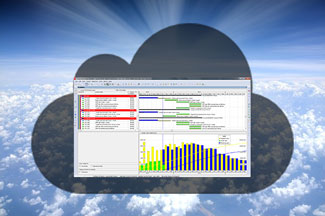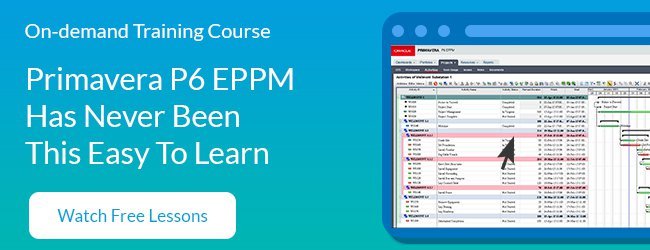It wasn’t that long ago that Oracle released the Oracle Primavera Cloud, a cloud-based offering for Oracle’s popular project management software packages. If you’ve been following the news, you might know that Oracle was a bit late to the cloud-party. Nonetheless, if you work in an enterprise with large Primavera installations, you’ll be happy they finally showed up – fashionably late albeit.
What is the Primavera Cloud Service?
Nowadays, software is moving to the cloud and being offered as service. For example, instead of purchasing individual copies Microsoft Office and installing them on a number of desktops, now you can purchase Microsoft Office 365, which offers the software as subscription service; you pay a much more reasonable price monthly and can access Office on desktops and mobile devices. The benefits for the end user are many: lower cost, automatic updates, accessibility over the web and much more.
In recent years, we’ve seen many software products launched using the SaaS (software-as-a-service) model, from Google Apps for Business, Adobe’s Creative Suite, to Canva – a graphic design tool that’s completely web-based.
Oracle has been behind but they are quickly playing catch-up and they have made a huge play for a piece of the cloud SaaS market with their Oracle Database Cloud and other Enterprise SaaS offerings too many to mention here.
It’s no surprise and a bit of a relief to see Primavera software move to the cloud. Many applications within the Primavera suite of tools are already 100% web-based like Contract Management, Primavera P6 EPPM and Unifier. So making the jump to a cloud-based version makes sense.
What Primavera Applications have Cloud versions?
There are quite a few applications under the Primavera umbrella – not just Primavera P6 Professional. The majority of Primavera applications are now available as a cloud service. That means companies can pay a monthly subscription to access this software over the internet from virtually any location.
Here is a list of the applications within the Primavera Suite that now have cloud versions:
| Application | Cloud | On Premise |
| Primavera P6 Professional | * | |
| Primavera P6 EPPM | ||
| Contract Management | ||
| Risk Management | ||
| Instantis EnterpriseTrack | ||
| Unifier | ||
| Primavera Prime | ||
| Primavera Portfolio Management |
That’s right, only P6 Professional, Risk Management and Primavera Portfolio Management do not currently have cloud offerings. I have no information on whether any such offerings are planned.
You’ll notice the (*) on Primavera P6 Professional. Let me explain. Primavera P6 Professional can be purchased alone, but it also comes bundled with P6 EPPM. For users that have the bundled version and are P6 Professional alongside P6 EPPM to connect to the same database, P6 Professional does connect to the cloud. It’s just not offered on it’s own for users who only want to use Primavera P6 Professional.
Are there Alternatives to the Primavera Cloud?
Absolutely! And I just want to say that I’m only trying to lay it all out for you. Plan Academy has no skin in this game, but to be helpful and informative.
There have been a number of companies that provide hosted solutions for Primavera applications for quite some time, even before Oracle’s Cloud showed up. I can’t tell you which one to choose, you’ll have to do your own research.
What are the benefits of moving to the Primavera Cloud or 3rd party hosting?
I use a few subscription-based services and I have to say, I really like this model. As entrepreneur, the costs stay down, while I get the latest and greatest version of the software. Let’s go through a few key benefits that might drive you to consider Primavera Cloud or an alternative.
1) Lower Costs
Without any details on pricing from Oracle, I’m going by what I’ve heard in a few webcasts and a brief conversation with a sales rep.
In any subscription model, your costs spread over a longer period of time, usually on a monthly plan, rather than paying a huge invoice upfront. And you only pay for what you use.
In the case of cloud hosted solutions, to realize the cost savings of an on-premise installation, you need to factor in all of those sunk costs of running and maintaining the software on-site:
- Hardware costs, electricity, etc.
- IT personel costs
- Additional software costs (virus checker, backup tools, database management, etc.)
According to Oracle, if you factor those costs in and compare to the pricing of their Primavera Cloud offering, you’re looking at substantial savings. You’ll have to get the details from them or a 3rd party.
2) Leave Installation Woes Behind
As a Primavera consultant, a big part of what I got paid to do (prior to Plan Academy) was help install and configure Primavera software. The range and scope of this type of work would vary from a few hours to a few weeks. Often there were problems – software conflicts, permissions not properly set, documentation that was incorrect or muddy at best. With a cloud install, you leave all of those headaches behind.
In a Cloud solution, the support people do all of the heavy lifting and make sure it’s all working before you get to it. It can make life a lot easier!
3) Upgrades are Easy
In cloud environments, updates, patches and upgrades are often pushed out all of the time. Think about your smartphone apps – new versions come out every other week. And with a Cloud installation, you get the same benefit.
My research tells me that with the Primavera Cloud, you can choose when to roll these out so you do have some control in the matter.
4) Scalability
Need to add more users or scale down? A Cloud solution is going to make that easy. So as a new project comes online, your enterprise can quickly and easily hire and add those users to the system. Simple.
Conclusion
Cloud-based solutions are here to stay and offer customers a lot more flexibility than on-premise installs, but they are not silver-bullet solutions. Nowadays, we have to consider Privacy and the Legal and security impacts of hosting our data elsewhere. However, the trend is up and it offers a lot of convenience for companies large and small.
Come back soon to read my next post in the Primavera Cloud series where I plan to go deeper to explain the Primavera P6 Cloud offering.
—


